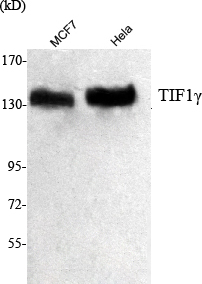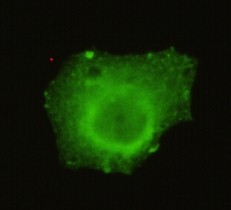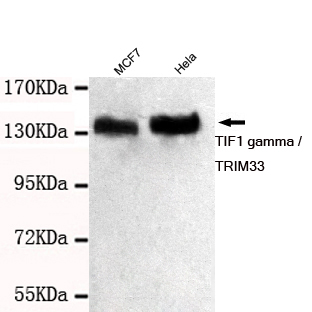TIF1γ Monoclonal Antibody
- Catalog No.:YM1108
- Applications:WB;IF;IHC
- Reactivity:Human;Mouse;Rat;Bovine;Dog;Pig
- Target:
- TIF1γ
- Gene Name:
- TRIM33
- Protein Name:
- E3 ubiquitin-protein ligase TRIM33
- Human Gene Id:
- 51592
- Human Swiss Prot No:
- Q9UPN9
- Mouse Gene Id:
- 94093
- Mouse Swiss Prot No:
- Q99PP7
- Immunogen:
- Purified recombinant human TIF1γ (C-terminus) protein fragments expressed in E.coli.
- Specificity:
- TIF1γ Monoclonal Antibody detects endogenous levels of TIF1γ protein.
- Formulation:
- Liquid in PBS containing 50% glycerol, 0.5% BSA and 0.02% sodium azide.
- Source:
- Monoclonal, Mouse
- Dilution:
- WB 1:1000 - 1:2000. IF 1:100 - 1:500. IHC 1:50-200 Not yet tested in other applications.
- Purification:
- Affinity purification
- Concentration:
- 1 mg/ml
- Storage Stability:
- -15°C to -25°C/1 year(Do not lower than -25°C)
- Other Name:
- TRIM33;KIAA1113;RFG7;TIF1G;E3 ubiquitin-protein ligase TRIM33;Ectodermin homolog;RET-fused gene 7 protein;Protein Rfg7;Transcription intermediary factor 1-gamma;TIF1-gamma;Tripartite motif-containing protein 33
- Molecular Weight(Da):
- 123kD
- Background:
- The protein encoded by this gene is thought to be a transcriptional corepressor. However, molecules that interact with this protein have not yet been identified. The protein is a member of the tripartite motif family. This motif includes three zinc-binding domains, a RING, a B-box type 1 and a B-box type 2, and a coiled-coil region. Three alternatively spliced transcript variants for this gene have been described, however, the full-length nature of one variant has not been determined. [provided by RefSeq, Jul 2008],
- Function:
- disease:A chromosomal aberration involving TRIM33 is a cause of thyroid papillary carcinoma (PACT) [MIM:188550]. Translocation t(1;10)(p13;q11) with RET. The translocation generates the TRIM33/RET (PTC7) oncogene.,function:Acts as an E3 ubiquitin-protein ligase. Promotes SMAD4 ubiquitination, nuclear exclusion and degradation via the ubiquitin proteasome pathway. According to PubMed:16751102, does not promote a decrease in the level of endogenous SMAD4. May act as a transcriptional repressor. Inhibits the transcriptional response to TGF-beta/BMP signaling cascade. Plays a role in the control of cell proliferation. Its association with SMAD2 and SMAD3 stimulates erythroid differentiation of hematopoietic stem/progenitor (By similarity). Monoubiquitinates SMAD4 and acts as an inhibitor of SMAD4-dependent TGF-beta/BMP signaling cascade (Monoubiquitination of SMAD4 hampers its ability to for
- Subcellular Location:
- Nucleus . In discrete nuclear dots resembling nuclear bodies. .
- Expression:
- Expressed in stem cells at the bottom of the crypts of the colon (at protein level). Expressed in colon adenomas and adenocarcinomas (at protein level). Expressed in brain, lung, liver, spleen, thymus, prostate, kidney, testis, heart, placenta, pancreas, small intestine, ovary, colon, skeletal muscle and hematopoietic progenitors.
- June 19-2018
- WESTERN IMMUNOBLOTTING PROTOCOL
- June 19-2018
- IMMUNOHISTOCHEMISTRY-PARAFFIN PROTOCOL
- June 19-2018
- IMMUNOFLUORESCENCE PROTOCOL
- September 08-2020
- FLOW-CYTOMEYRT-PROTOCOL
- May 20-2022
- Cell-Based ELISA│解您多样本WB检测之困扰
- July 13-2018
- CELL-BASED-ELISA-PROTOCOL-FOR-ACETYL-PROTEIN
- July 13-2018
- CELL-BASED-ELISA-PROTOCOL-FOR-PHOSPHO-PROTEIN
- July 13-2018
- Antibody-FAQs
- Products Images

- Western Blot analysis using TIF1γ Monoclonal Antibody against MCF7 cell lysate, HeLa nuclear extract.

- Immunofluorescence analysis of HeLa cells using TIF1γ Monoclonal Antibody.


